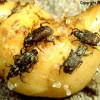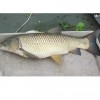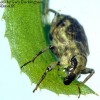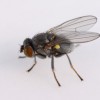 Trichopria columbiana is a parasitoid of Hydrellia fly species. Depending on the ecological role of the host species, it can have a positive or negative effect on biological control. Some Hydrellia species feed on the invasive aquatic weed hydrilla. After its introduction into the U.S. by the aquarium industry in the 1950s (Langeland 1996), various control methods, including biological control, were developed and used to manage infestations. Classical biological control studies were initiated in the 1970s, which led to the release of four insects in the U.S., two of which were the leaf-mining ephydrid flies, Hydrellia pakistanae and Hydrellia balciunasi. Despite successful establishment and range expansion of the Asian hydrilla leaf mining fly, Hydrellia pakistanae, population levels of the insect and associated plant damage have remained low. One of the potentially limiting biotic factors is parasitism by the native endoparasitic wasp Trichopria columbiana. This 6-page fact sheet was written by Byron R. Coon, Nathan E. Harms, Michael J. Grodowitz, Emma N.I. Weeks, and James P. Cuda, and published by the UF Department of Entomology and Nematology, June 2014.
Trichopria columbiana is a parasitoid of Hydrellia fly species. Depending on the ecological role of the host species, it can have a positive or negative effect on biological control. Some Hydrellia species feed on the invasive aquatic weed hydrilla. After its introduction into the U.S. by the aquarium industry in the 1950s (Langeland 1996), various control methods, including biological control, were developed and used to manage infestations. Classical biological control studies were initiated in the 1970s, which led to the release of four insects in the U.S., two of which were the leaf-mining ephydrid flies, Hydrellia pakistanae and Hydrellia balciunasi. Despite successful establishment and range expansion of the Asian hydrilla leaf mining fly, Hydrellia pakistanae, population levels of the insect and associated plant damage have remained low. One of the potentially limiting biotic factors is parasitism by the native endoparasitic wasp Trichopria columbiana. This 6-page fact sheet was written by Byron R. Coon, Nathan E. Harms, Michael J. Grodowitz, Emma N.I. Weeks, and James P. Cuda, and published by the UF Department of Entomology and Nematology, June 2014.
http://edis.ifas.ufl.edu/in1040
Tag: Hydrilla — Biological Control
Hydrilla tuber weevil Bagous affinis Hustache (Insecta: Coleoptera: Curculionidae)
 Bagous affinis Hustache is a semi-aquatic weevil that feeds on the aquatic invasive plant Hydrilla verticillata (L.f.) Royle. The larvae of the weevil mine hydrilla tubers, and the adults feed on the submerged stems and leaves. The weevil was discovered during surveys for biological control agents for hydrilla in Pakistan in 1980 and was first introduced to the U.S. in Florida from India in 1987. This 5-page fact sheet was written by Emma Weeks, and published by the UF Department of Entomology and Nematology, June 2014.
Bagous affinis Hustache is a semi-aquatic weevil that feeds on the aquatic invasive plant Hydrilla verticillata (L.f.) Royle. The larvae of the weevil mine hydrilla tubers, and the adults feed on the submerged stems and leaves. The weevil was discovered during surveys for biological control agents for hydrilla in Pakistan in 1980 and was first introduced to the U.S. in Florida from India in 1987. This 5-page fact sheet was written by Emma Weeks, and published by the UF Department of Entomology and Nematology, June 2014.
http://edis.ifas.ufl.edu/in1039
Grass Carp, the White Amur: Ctenopharyngodon idella Cuvier and Valenciennes (Actinopterygii: Cyprinidae: Squaliobarbinae)
 The grass carp, Ctenopharyngodon idella Cuvier and Valenciennes, was imported to the U.S. in 1963 as a biological control agent for hydrilla (Hydrilla verticilliata (L.f.) Royle) and other aquatic plants. Concerns of escape and reproduction, and the potential impacts that colonization of the fish could have on native flora and fauna led to research that developed a non-reproductive fish, which was equally effective in controlling hydrilla. In the warm waters of Florida, with abundant food, grass carp grow quickly at around 2 lbs/month or 0.91 kg/month and may achieve weights of 97 lbs (44 kg). Younger fish and female fish grow faster than older or male fish. Grass carp are the most effective biological control tool that has been identified for hydrilla. This 7-page fact sheet was written by Emma N.I. Weeks and Jeffrey E. Hill, and published by the UF Department of Entomology and Nematology, June 2014.
The grass carp, Ctenopharyngodon idella Cuvier and Valenciennes, was imported to the U.S. in 1963 as a biological control agent for hydrilla (Hydrilla verticilliata (L.f.) Royle) and other aquatic plants. Concerns of escape and reproduction, and the potential impacts that colonization of the fish could have on native flora and fauna led to research that developed a non-reproductive fish, which was equally effective in controlling hydrilla. In the warm waters of Florida, with abundant food, grass carp grow quickly at around 2 lbs/month or 0.91 kg/month and may achieve weights of 97 lbs (44 kg). Younger fish and female fish grow faster than older or male fish. Grass carp are the most effective biological control tool that has been identified for hydrilla. This 7-page fact sheet was written by Emma N.I. Weeks and Jeffrey E. Hill, and published by the UF Department of Entomology and Nematology, June 2014.
http://edis.ifas.ufl.edu/in1038
Hydrilla Stem Weevil Bagous Hydrillae O’Brien
 Bagous hydrillae O’Brien is a semi-aquatic weevil that feeds on the aquatic invasive weed Hydrilla verticillata (L.f.) Royle. Larvae of the weevil mine hydrilla stems and the adults feed on the stems and submerged leaves. This weevil was discovered during overseas surveys for biological control agents for hydrilla during the 1980s and was first introduced to the U.S. in Florida in 1991 after extensive host-specificity testing. This 5-page fact sheet was written by Emma Weeks, Jim Cuda, and Michael J. Grodowitz, and published by the UF Department of Entomology and Nematology, June 2014.
Bagous hydrillae O’Brien is a semi-aquatic weevil that feeds on the aquatic invasive weed Hydrilla verticillata (L.f.) Royle. Larvae of the weevil mine hydrilla stems and the adults feed on the stems and submerged leaves. This weevil was discovered during overseas surveys for biological control agents for hydrilla during the 1980s and was first introduced to the U.S. in Florida in 1991 after extensive host-specificity testing. This 5-page fact sheet was written by Emma Weeks, Jim Cuda, and Michael J. Grodowitz, and published by the UF Department of Entomology and Nematology, June 2014.
http://edis.ifas.ufl.edu/in1036
Hydrilla leaf mining flies (unofficial common name) Hydrellia spp. (Insecta: Diptera: Ephydridae)
http://edis.ifas.ufl.edu/in1034 Several native and introduced species of flies in the genus Hydrellia are important because they feed on hydrilla (Hydrilla verticillata L.f. Royle), an invasive aquatic plant that has been classified as a Federal Noxious Weed. Hydrilla has invaded aquatic ecosystems in Florida and across the U.S. Larvae of Hydrellia spp. mine the leaves of hydrilla. In Florida, there are four species that have been associated with the invasive aquatic weed hydrilla: two native species and two species that were introduced for biological control of hydrilla. The native species are Hydrellia bilobifera Cresson and Hydrellia discursa Deonier. The introduced species are Hydrellia pakistanae Deonier and Hydrellia balciunasi Bock. This 6-page fact sheet was written by Emma Weeks and James Cuda, and published by the UF Department of Entomology and Nematology, April 2014.
Several native and introduced species of flies in the genus Hydrellia are important because they feed on hydrilla (Hydrilla verticillata L.f. Royle), an invasive aquatic plant that has been classified as a Federal Noxious Weed. Hydrilla has invaded aquatic ecosystems in Florida and across the U.S. Larvae of Hydrellia spp. mine the leaves of hydrilla. In Florida, there are four species that have been associated with the invasive aquatic weed hydrilla: two native species and two species that were introduced for biological control of hydrilla. The native species are Hydrellia bilobifera Cresson and Hydrellia discursa Deonier. The introduced species are Hydrellia pakistanae Deonier and Hydrellia balciunasi Bock. This 6-page fact sheet was written by Emma Weeks and James Cuda, and published by the UF Department of Entomology and Nematology, April 2014.